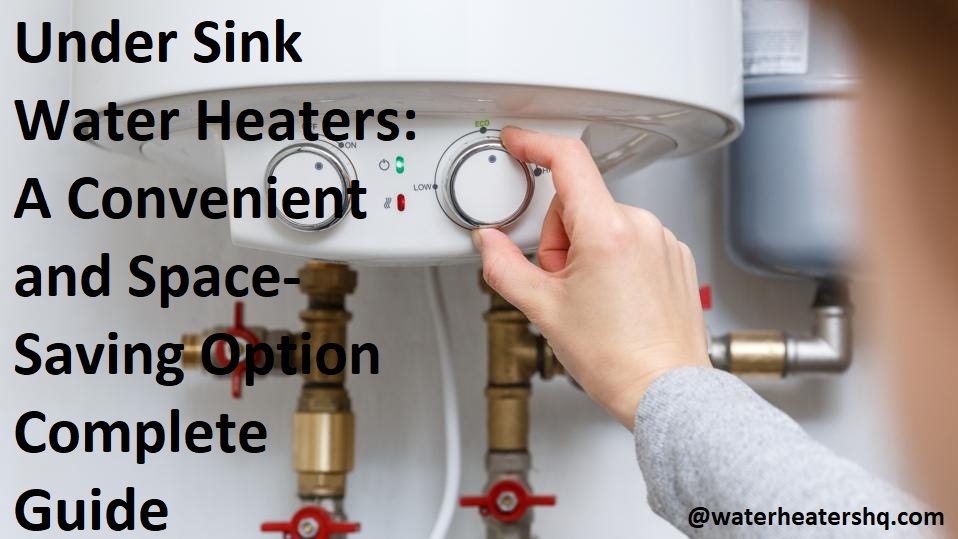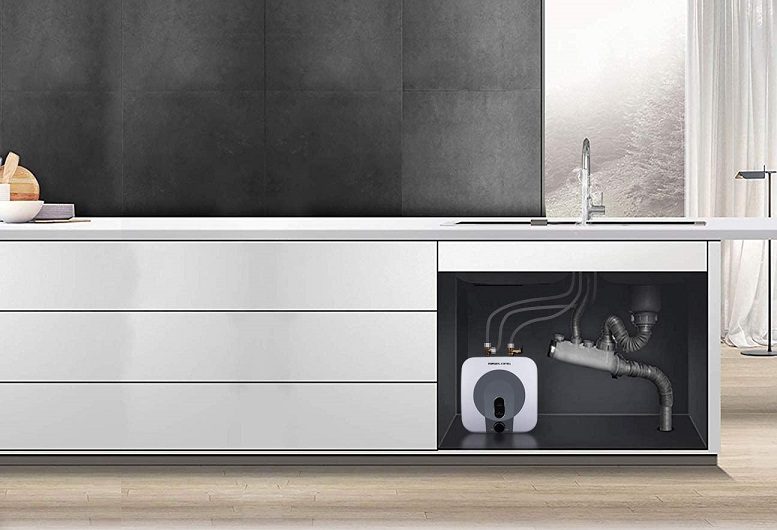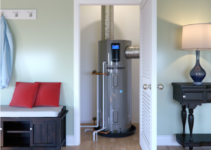Are you looking for an efficient way to get hot water, while preserving the limited space under your sink? Look no further!
A convenient and space-saving option, an under sink water heater is just what you need. This guide will help you find the perfect one to fit your needs.
Under sink water heaters are a convenient and space-saving solution for hot water. They provide a reliable source of heated water right where you need it, whether it’s in a kitchen or bathroom. With their small size and easy installation, they’re perfect for tight apartments and smaller homes.
Under sink water heaters come in a variety of sizes, shapes, and powers to suit different needs. Depending on the size you choose and where you install the unit, they can provide enough hot water for an entire household or just a single tap. Under sink heaters are relatively simple to install and maintain, compared to having separate hot/cold water pipes running across your house or apartment.
This comprehensive guide will help you understand the types of under sink water heaters available, how to choose one that meets your needs, and how to install it properly so that you’ll be able get continuous hot water at the tap.
Definition of under sink water heaters
Under sink water heaters are convenient and efficient water-heating systems that can provide hot water instantly. As the name suggests, these systems are installed under the sink in order to make the most out of limited available space. The typical system consists of a tank, valve, lines and wiring necessary for operation. These heaters can be used for kitchen sinks as well as bathrooms.
The advantage of having an under sink system is that it saves space compared to traditional hot water tanks, which can take up valuable storage room in the basement or garage. In addition to providing instant hot water, these systems offer more precise temperature control than tankless models and some models even come with adjustable thermostats that allow you to customize the temperature you need according to your needs.
Under sink water heaters offer other advantages: they are energy efficient; they require minimal maintenance; they take up very little floor space; they provide quick access to hot water; and they are environmentally friendly, since no fuel is required to power them up. They can also be less expensive than traditional heating systems. When comparing models, it is important to look at size, energy rating and overall cost before making a purchase decision.

Benefits of using under sink water heaters
Under sink water heaters offer many benefits to busy households. They provide hot water on demand and they require minimal space. For example, because they are installed beneath the sink, they can save valuable countertop and cabinet real estate. Additionally, these units are much quieter than typical tankless systems and are designed with internal temperature controls for safety and accuracy. Lastly, due to the technology used in the heating element of under sink water heaters, water is heated quickly and efficiently with minimal waiting time from start-up to delivery of hot water.
All of these factors combine to create safe and convenient hot water usage for all your kitchen needs— from washing dishes to filling pasta pots or even cleaning up after family pets. And because every unit is tailored to fit under most kitchen sinks, installation is fast and easy compared to traditional tanked units that need a larger dedicated space for operation. Under sink water heaters also provide energy savings since only the hot water you need is heated— making them one of the most efficient models available on today’s market.
Purpose of the complete guide
This complete guide will help you to understand the advantages, disadvantages and installation considerations for using an under sink water heater as part of your home plumbing system. We will explain potential issues related to high water pressures, indicate the best types of elements for heaters with certain water usage levels, and provide tips on selecting an appropriate size unit. We also take into account safety features such as temperature regulation, shutoffs and energy saving options.
Understanding why under sink hot water heaters are suitable for home applications is the first step in making an informed purchase decision. These appliances are often used in locations where there is limited space or a need to conserve water. They deliver hot water efficiently at a lower cost compared to larger houses with conventional tank-type systems while also providing quick access points near sinks or showers that require heated water. With careful installation, they can be made safe and compatible with most home plumbing systems.
Additionally, you will learn the basics of plumbing associated with these units such as proper ventilation, installation of necessary temperature pan valves and thermal expansion tanks to prevent sudden pressure changes due their unique operating environment. Further information about wiring and other electric requirements is also included for a comprehensive review prior to installing this type of system in your residence or other location.
Factors to consider when choosing an under sink water heater
Before deciding on an under sink water heater, there are a few factors that need to be taken into consideration in order to ensure that you get the right one. These include:
-Size: Depending on the available space, you need to choose a model with a suitable size and capacity.
-Input power: Check the maximum input power of your selected model and make sure it’s compatible with your home’s electrical system.
-Water pressure: Some models require a specific water pressure in order to work efficiently. Verify that your selected model is suitable for your particular water pressure requirements.
-Energy efficiency: Make sure to check the energy efficiency rating of your chosen model; this will also help you decide which type of fuel is best for you. Electric models tend to be more efficient than gas ones but also more costly to purchase and install.
-Installation requirements: Installing an under sink water heater typically requires professional help, so be sure that your chosen model has all necessary installation hardware included or that it’s compatible with existing materials and accessories in your plumbing system.
Capacity
The capacity of an under sink water heater is an important factor when making the decision to purchase one. It should be noted that the temperature rating is more typically displayed in terms of gallons per minute and not volume. This measurement usually ranges from four to seven gallons per minute and it refers to the amount of hot water a unit can provide during peak usage.
Larger households may require a unit with a higher capacity, whereas for smaller households, a lower capacity unit may suffice. When choosing the right under sink water heater for your home, it’s important to do your research and compare various models before coming to a decision.
Energy efficiency
Energy efficiency is an important factor to consider when evaluating under sink water heaters. As a home appliances, these models tend to be more energy efficient than tank-style models. This is due in part to the fact that they are able to deliver the hot water faster because they’re located closer to the sink. Additionally, because of their smaller size, under sink water heaters keep a smaller quantity of hot water on hand at any given time. This reduces the amount of energy required for storage and reheating–saving you money on both your energy and water bills.
Most under sink water heaters have an Energy Star label indicating that they meet or exceed energy efficiency standards set by the EPA. Additionally, many have adjustable temperature settings so you can choose how hot or cool you want your water to be–this too will add to their overall efficiency. Consider choosing a model with an insulated tank, which may further improve its energy performance.
Cost
The cost of an under sink water heater can vary greatly, depending on the size of the unit and the energy source. Electric under sink water heaters tend to cost more initially, but they often require less maintenance over time. In addition, electric models are typically smaller in size so they fit into tight spaces more easily.
Gas units are more expensive to install but may have lower running costs because you don’t have to pay for electricity to run them. However, gas units may require more frequent maintenance due to possible problems with gas lines or connections in the home.
When choosing an under sink water heater, it is important to factor in installation costs as well as any additional features that may affect cost such as timers and thermostats for temperature control and display panels for easy operation. Be sure to also factor in possible warranty costs that could be necessary if any problems arise after installation has been completed.
Installation of under sink water heaters
Before beginning the installation process it is important to have a thorough understanding of the specific model and system. Installation of under sink water heaters should typically be done by a qualified professional or licensed contractor and vary based on each unit. Check with manufacturers for detailed instructions to ensure safe and proper installation.
A review of local building codes should take place before purchasing an under sink water heater. Depending on local codes the heater may need to be installed by a professional plumber in compliance with all necessary regulations. Once any permitting requirements are satisfied, turn off the power supply to avoid electric shock during installation.
Generally speaking, most models require access from below due to their slim size and shape, so check all possible locations for accessible space before purchasing equipment, since this will determine placement requirements during installation as well as how much piping needs to be run from cold water lines up to the new unit’s location. The angle of intended pipes must also be considered for an optimal layout for easy water flow and pressure throughout the system, such as with copper or PEX tubing that is formed at a slight angle away from walls upward towards heater connection points.
Finally, after ensuring all components are connected properly tighten all fasteners uniformly around manifold bolts and nuts while considering relevant pressure ratings on specific units when appropriate in order to ensure secure connections between parts and solid operation of the entire system once it is commissioned.

Necessary tools and equipment
A under sink water heater provides hot water in a space-saving way that increases the efficiency of the water heater. It is important to have all of the necessary tools, materials and equipment available in order to properly install a new or replacement under sink water heater.
All necessary tools and equipment required for installation of an under sink water heater include: drainage pipe wrench, adjustable wrench or pipe cutters, measuring tape, torpedo level, adjustable pliers, screwdrivers and a hacksaw. Safety gear such as safety glasses or googles are also recommended. You will also need to ensure that PEX piping and plumbing materials for the installation are suited for your specific model.
Once you have acquired all necessary items for your installation directly from your selected manufacturer or home improvement retailer and before you install any new or replacement under sink water heaters it is essential that you read through the included instructions carefully before proceeding with any work. This will help you to identify any potential hazards involved with working on these types of appliances, as well as the right way of doing it correctly.
Maintenance of under sink water heaters
Under sink water heaters are designed to be maintenance-free and hassle-free, but there are a few things that you should check periodically to ensure that the system is working properly. The first step in any maintenance routine should be to check your user’s manual for specific instructions on how to take care of your specific under sink water heater model.
Once you have gotten your user’s manual, you should double-check on certain aspects of the heater at least once a month. Make sure that all of the connections from the tank to the stove and from the tank to the hot water valve are tight. Tighten all of these connections if necessary with a large adjustable wrench. You should also check for any water leakage around or beneath the unit itself, as this can cause significant damage over time if left unchecked. If you do find any leaks, carefully tighten or replace any faulty parts until no further leakage occurs.
It is also important to inspect and flush out the cold water supply line from time to time in order to keep it free from sediment buildup that can reduce its efficiency over time. This can usually be done simply by removing the filter screen located at one end of your cold supply line, filling it with a solution of white vinegar and letting it sit overnight before flushing it with fresh clean water in the morning – repeat this process every two months or so if necessary.
Finally, when performing any kind of maintenance procedure on an under sink hot water heater, make sure that you wear appropriate safety equipment (like rubber gloves and safety goggles) while working on it – they may not seem important but taking proper precautions is always better than risking injury!
Regular cleaning and flushing
Regular cleaning and flushing of the under sink water heaters is important in order to maintain their efficiency and prevent any damage due to calcification or sediment buildup. The frequency of cleaning and flushing will depend on the location, quality of water, and usage, with more regular cleaning being needed in areas with hard water.
Firstly, the tank should be emptied and drained on a regular basis. Depending on the model, this may need to be done every three months or up to once a year. Then the tank should be scrubbed with hot soapy water and rinsed clean until all traces of soap are gone. After that, some vinegar (white or apple cider) should be gently poured into the tank and left overnight before it is flushed out with clear tap water in the morning. Finally a cleaner specifically designed for removing mineral deposits from water tanks can be used according to package instructions if necessary. This will help keep the scale build-up at bay and maintain an optimal level of efficiency for your heater.
Replacement of parts
When it comes to replacing parts with an under sink water heater, the procedure is relatively straightforward. The user manual should list all of the items needed and whether or not the item needs professional installation. Here are some common parts that may need to be replaced over time:
Thermostat: This is the part that controls the temperature, and it should be set at desired levels for optimal performance. In most cases, this can be done simple by repositioning a dial or setting a numeric temperature value.
Heat Exchanger/Venting/Connections: The heat exchanger is responsible for transferring heat from one source to another and insulating against energy loss. Venting keeps air pressure levels under control, ensuring that there is sufficient air intake for an optimal experience. Connections attach pipes and fittings together, providing a tight seal for a secure fitment.
Anode Rod: The Anode rod protects against corrosion, which can cause problems in any water system due to its composition of salt and minerals. If this rod shows signs of wear or damage, it should always be replaced immediately to prevent further damage from occurring.
Pressure Relief Valve: This valve is installed to help reduce pressure buildup -causing catastrophic damage if unattended -so ensuring it’s functioning property is key in preserving the life of an under sink water heater system as well as its user’s safety.

Conclusion
In conclusion, under sink water heaters provide a convenient and space-saving option for households looking to keep water hot and running without sacrificing valuable real estate or energy waste. These units are known to have high energy efficiency ratings, making them both cost-effective and eco-friendly.
Be sure to consult with a qualified plumber to determine if an under sink water heater is right for your home, as each installation is unique. With the right installation and proper maintenance, you can enjoy all of the benefits of having hot water in your bathroom or kitchen without using up any extra precious space.
FAQ’S
Do under sink water heaters save money?
Under sink water heaters can save money by reducing the amount of water and energy required to heat water, but the amount of savings will depend on factors such as the size of the unit, the cost of electricity or gas, and the frequency of use.
What is a point of use water heater under the kitchen sink?
A point of use water heater under the kitchen sink is a small, compact unit that provides hot water on demand for a specific location, such as the kitchen sink.
What is the most efficient water heater option?
The most efficient water heater option will depend on the specific needs and circumstances of the user, but options such as tankless or heat pump water heaters are generally considered more efficient than traditional storage tank water heaters.
Should I get over or under sink water heater?
The choice between an over or under sink water heater will depend on the specific needs and circumstances of the user, such as the size of the space, frequency of use, and availability of electrical or plumbing connections.
How long do under sink water heaters last?
The lifespan of an under sink water heater can vary depending on factors such as the quality of the unit, frequency of use, and maintenance, but they typically last between 5-10 years.
Which water heater is best for the kitchen?
The best water heater for the kitchen will depend on the specific needs and circumstances of the user, but options such as point of use, tankless, or small storage tank water heaters are often used for kitchen applications.
What is the cheapest way for hot water?
The cheapest way for hot water will depend on the specific circumstances of the user, but options such as using natural gas or using a timer to reduce the amount of time the water heater operates can help reduce costs.
What is the most efficient way to heat a home?
The most efficient way to heat a home will depend on factors such as the climate, size and layout of the home, and energy costs, but options such as geothermal, radiant floor heating, or high-efficiency heat pumps are often considered efficient options.
What are the advantages and disadvantages of water heater?
Advantages of a water heater include providing hot water on demand, convenience, and comfort. Disadvantages may include energy costs, maintenance requirements, and the potential for leaks or other issues.
What is the disadvantage of hot water heater?
Disadvantages of a hot water heater may include energy costs, maintenance requirements, and the potential for leaks or other issues.
See Also:
- Best power vent water heater
- Best propane tankless water heater
- Best solar water heater
- Best tankless water heater
- Best under sink water heater


